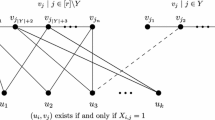Abstract
In this paper we study distributed algorithms on massive graphs where links represent a particular relationship between nodes (for instance, nodes may represent phone numbers and links may indicate telephone calls). Since such graphs are massive they need to be processed in a distributed way. When computing graph-theoretic properties, nodes become natural units for distributed computation. Links do not necessarily represent communication channels between the computing units and therefore do not restrict the communication flow. Our goal is to model and analyze the computational power of such distributed systems where one computing unit is assigned to each node. Communication takes place on a whiteboard where each node is allowed to write at most one message. Every node can read the contents of the whiteboard and, when activated, can write one small message based on its local knowledge. When the protocol terminates its output is computed from the final contents of the whiteboard. We describe four synchronization models for accessing the whiteboard. We show that message size and synchronization power constitute two orthogonal hierarchies for these systems. We exhibit problems that separate these models, i.e., that can be solved in one model but not in a weaker one, even with increased message size. These problems are related to maximal independent set and connectivity. We also exhibit problems that require a given message size independently of the synchronization model.


Similar content being viewed by others
References
Babai, L., Gál, A., Kimmel, P.G., Lokam, S.V.: Communication complexity of simultaneous messages. SIAM J. Comput. 33, 137–166 (2004)
Becker, F., Matamala, M., Nisse, N., Rapaport, I., Suchan, K., Todinca, I.: Adding a referee to an interconnection network: What can(not) be computed in one round. In: Parallel and Distributed Processing Symposium, International, pp. 508–514. IEEE Computer Society (2011)
Chandra, A.K., Furst, M.L., Lipton, R.J.: Multi-party protocols. In: Proceedings of the 15th Annual ACM Symposium on Theory of Computing, STOC ’83, pp. 94–99. ACM (1983)
Feldman, J., Muthukrishnan, S.M., Sidiropoulos, A., Stein, C., Svitkina, Z.: On distributing symmetric streaming computations. ACM Trans. Algorithms 6, 66:1–66:19 (2010)
Fraigniaud, P., Korman, A., Peleg, D.: Towards a complexity theory for local distributed computing. J. ACM 60(5), 35 (2013)
Grumbach, S., Wu, Z.: Logical locality entails frugal distributed computation over graphs. In: Proceedings of 35th International Workshop on Graph-Theoretic Concepts in Computer Science (WG), Lecture Notes in Computer Science, 5911, pp. 154–165 (2009)
Kostochka, A.V.: Lower bound of the Hadwiger number of graphs by their average degree. Combinatorica 4(4), 307–316 (1984)
Kuhn, F., Moscibroda, T., Wattenhofer, R.: What cannot be computed locally! In: Proceedings of the 23rd Annual ACM Symposium on Principles of Distributed Computing (PODC), pp. 300–309. ACM (2004)
Linial, N.: Locality in distributed graph algorithms. SIAM J. Comput. 21(1), 193–201 (1992)
Naor, M., Stockmeyer, L.: What can be computed locally? SIAM J. Comput. 24(6), 1259–1277 (1995)
Peleg, D.: Distributed computing: a locality-sensitive approach. SIAM Monographs on Discrete Mathematics and Applications (2000)
Thomason, A.: An extremal function for contractions of graphs. Math. Proc. Cambridge Philos. Soc. 95, 261–265 (1984)
Thomason, A.: The extremal function for complete minors. J. Comb. Theory. Ser. B 81(2), 318–338 (2001)
Wright, E.: Equal sums of like powers. Bull. Amer. Math. Soc. 8, 755–757 (1948)
Author information
Authors and Affiliations
Corresponding author
Additional information
This paper is the union of two preliminary versions appeared in the proceedings of SPAA 2012 (Allowing each node to communicate only once in a distributed system: shared whiteboard models) and IPDPS 2011 (Adding a referee to an interconnection network: What can (not) be computed in one round?). It has been partially supported by programs Fondap and Basal-CMM (M.M., I.R., K.S.), Fondecyt 1100192 (M.M.), 1130061 (I.R.), FP7 STREP EULER (N.N.), ANR AGAPE (I.T.), ANR Displexity (A.K.), NCN under contract DEC-2011/02/A/ST6/00201 (A.K.), Ecos-Conicyt C09E04 (M.M., I.R., I.T.), Ecos-Sud Chili C12E03 (N.N, K.S.) and Associated Team Inria AlDyNet (N.N, K.S.).
Rights and permissions
About this article
Cite this article
Becker, F., Kosowski, A., Matamala, M. et al. Allowing each node to communicate only once in a distributed system: shared whiteboard models. Distrib. Comput. 28, 189–200 (2015). https://doi.org/10.1007/s00446-014-0221-8
Received:
Accepted:
Published:
Issue Date:
DOI: https://doi.org/10.1007/s00446-014-0221-8




